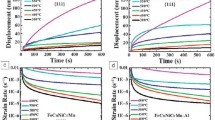Abstract
Combined nanoindentation and glancing angle X-ray diffraction (GAXD) methods were used to study the mechanical properties of near-surface microstructures (NSMs) of a hot-rolled 5xxx aluminum alloy. Nanoindentations with a sharp indenter were carried out with penetration depth ranging from 250 nm to 4500 nm at the near-surface regions as well as the bulk of the hot-rolled alloy. The primary indentation parameter presented here was the hardness, given that plastic strain obtained from GAXD experiment could be correlated with the hardness value. Analysis of nanoindentation hardness results proved that NSMs of this alloy on average were harder than the bulk due to the presence of different surface features discussed here. The GAXD experiments were performed between a minimum incident angle 0.025°, equivalent to 765 nm penetration depth, and a maximum angle 1°, equivalent to 3000 nm penetration depth. The strain-induced broadening in the diffraction peaks was calculated by the Williamson–Hall technique. Both indentation hardness and glancing angle diffraction results confirmed strain gradient as a function of depth in the NSMs of the alloy. Both techniques also showed that the thickness of the subsurface layer (i.e., several micrometers below the surface) of hot-rolled sample was approximately 2.44 μm at the tested areas. Additionally, reported results provided evidence for the ability to use glancing angle X-ray diffraction as a nondestructive tool for the measurement of subsurface layers' thickness as well as microstrain (non-uniform or plastic strain) as a function of depth.





Similar content being viewed by others
References
Y. Fukuda, M. Noda, T. Ito, K. Suzuki, N. Saito, and Y. Chino, Effect of Reduction in Thickness and Rolling Conditions on Mechanical Properties and Microstructure of Rolled Mg-8Al-1Zn-1Ca Alloy. Adv. Mater. Sci. Eng. (2017). https://doi.org/10.1155/2017/4065434
O.A. Gali, M. Shafiei, J.A. Hunter, and A.R. Riahi, The Influence of Hot Rolling on Oxide Development Within Micro-Cracks of Aluminum-Magnesium Alloys, Mater. Sci. Eng. A, 2014, 618, p 129–141
J. Wang, X. Zhou, G.E. Thompson, J.A. Hunter, and Y. Yuan, Delamination of Near-Surface Layer on Cold Rolled AlFeSi Alloy During Sheet Forming, Mater. Charact., 2015, 99, p 109–117
M.F. Frolish, J.C. Walker, C. Jiao, W.M. Rainforth, and J.H. Beynon, Formation and Structure of a Subsurface Layer in Hot Rolled Aluminium Alloy AA3104 Transfer Bar, Tribol. Int., 2005, 38(11–12), p 1050–1058
Q. Zhao, Effect of Roll Material on Surface Quality of Rolled Aluminum. Electronic Theses and Dissertations. Paper 5080 (2014)
M. Fishkis and J.C. Lin, Formation and Evolution of a Subsurfacenext Term Layer in a Metalworking Process, Wear, 1997, 206(June 1996), p 156–170
J. Wang, X. Zhou, G.E. Thompson, J.A. Hunter, and Y. Yuan, Near-Surface Microstructure on Twin-Roll Cast 8906 Aluminum Alloy, Metall. Mater. Trans. A Phys. Metall. Mater. Sci., 2015, 46(6), p 2688–2695
X. Zhou, Y. Liu, G.E. Thompson, G.M. Scamans, P. Skeldon, and J.A. Hunter, Near-Surface Deformed Layers on Rolled Aluminum Alloys, Metall. Mater. Trans. A Phys. Metall. Mater. Sci., 2011, 42(5), p 1373–1385
O.A. Gali, M. Shafiei, J.A. Hunter, and A.R. Riahi, The Development of Near-Surface Microstructures During Hot Rolling of Aluminum-Magnesium Alloys in Relation to Work Roll Topography, Surf. Interface Anal., 2016, 48(8), p 889–898
O.A. Gali, M. Shafiei, J.A. Hunter, and A.R. Riahi, The Characterization of Near-Surface Defects Evolved on Aluminum-Manganese Alloys During Hot Rolling, Surf. Interface Anal., 2016, 48(8), p 877–888
Y. Liu et al., Influence of Near-Surface Deformed Layers on Filiform Corrosion of AA3104 Aluminium Alloy, Surf. Interface Anal., 2013, 45(10), p 1553–1557
S. Das, A.R. Riahi, X. Meng-Burany, A.T. Morales, and A.T. Alpas, High Temperature Deformation and Fracture of Tribo-Layers on the Surface of AA5083 Sheet Aluminum-Magnesium Alloy, Mater. Sci. Eng. A, 2012, 531, p 76–83
M.F. Doerner, A Method for Interpreting the Data from Depth-Sensing Indentation Instruments, J. Mater. Res., 1986, 1(4), p 601–609
W.C. Oliver, Measurement of Hardness and Elastic Modulus by Instrumented Indentation: Advances in Understanding and Refinements to Methodology, J. Mater. Res., 2004, 19(1), p 3–20
A.C. Fischer-Cripps, Nanoindentation, Springer, New York, 2004
M.S. Bobji and S.K. Biswas, Deconvolution of Hardness from Data Obtained from Nanoindentation of Rough Surfaces, J. Mater. Res., 1999, 14(6), p 2259–2268
M. Novotny, R. Kuz, and M. Society, On X-Ray Diffraction Study of Microstructure of ZnO Thin Nanocrystalline Films with Strong Preferred Grain Orientation, Metall. Mater. Trans., 2013, 44(January), p 45–57
A.M. Korsunsky and G.M. Regino, Residual Stresses in Rolled and Machined Nickel Alloy Plates: Synchrotron X-Ray Diffraction Measurement and Three-Dimensional Eigen Strain Analysis, J. Strain Anal. Eng. Des., 2007, 42, p 1–2
P. Colombi, P. Zanola, E. Bontempi, R. Roberti, M. Gelfi, and L.E. Depero, Glancing-Incidence X-Ray Diffraction for Depth Profiling of Polycrystalline Layers, J. Appl. Crystallogr., 2006, 39(2), p 176–179
D. Tabor, Hardness of Metals, Clarendon Press, Oxford, 1951
G.K. Williamson and W.H. Hall, X-Ray Line Broadening from Filed Aluminium and Wolfram, Acta Metall., 1953, 1(1), p 22–31
G.M. Pharr, E.G. Herbert, and Y. Gao, The Indentation Size Effect: A Critical Examination of Experimental Observations and Mechanistic Interpretations, Annu. Rev. Mater. Res., 2010, 40(1), p 271–292
M.S. Bobji, Estimation of Hardness Nanoindentation of Rough Surfaces, J. Mater. Res., 1998, 13(11), p 7
M.R. Begley and J.W. Hutchinson, The Mechanics of Size Dependent Indentation, J. Mech. Phys. Solids, 1938, 46, p 1938–1957
T. Noma, K. Takada, and A. Iida, Surface-Sensitive X-Ray Fluorescence and Diffraction Analysis with Grazing-Exit Geometry, X-Ray Spectrom., 1999, 439(May), p 433–439
Acknowledgments
Financial support for this research was provided by Novelis Global Research and Technology Center. We gratefully acknowledge the IEN/IMAT Materials Characterization Facility at Georgia Institute of Technology.
Author information
Authors and Affiliations
Corresponding author
Additional information
Publisher's Note
Springer Nature remains neutral with regard to jurisdictional claims in published maps and institutional affiliations.
Rights and permissions
About this article
Cite this article
Parvinian, S., Hoar, E., Tavakoli, D. et al. Through-Thickness Strain Gradient in a Hot-Rolled Al-Mg Alloy Obtained by Nanoindentation and Glancing Angle X-Ray Diffraction. J. of Materi Eng and Perform 28, 6897–6903 (2019). https://doi.org/10.1007/s11665-019-04400-9
Received:
Revised:
Published:
Issue Date:
DOI: https://doi.org/10.1007/s11665-019-04400-9



